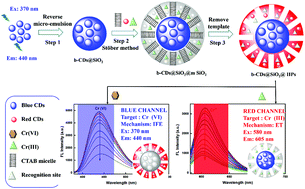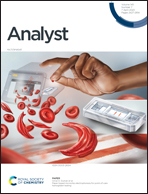Dual channel ion imprinted fluorescent polymers for dual mode simultaneous chromium speciation analysis†
Abstract
A simple core shell structured fluorescent sensor was constructed to realize simultaneous detection of hexavalent and trivalent chromium ions. Briefly, blue-carbon dots (b-CDs) were embedded into a silica sphere, then a Cr(III) imprinted silica layer doped with red-CDs (r-CDs) was coated onto the b-CDs@SiO2. Cr(VI) can selectively quench b-CDs based on the inner filter effect and Cr(III) can selectively quench r-CDs based on electron transfer with the aid of the ion imprinting technique. In this strategy, it was not necessary to reduce Cr(VI) to Cr(III) or oxidize Cr(III) to Cr(VI), the chromium speciation of both can be detected simultaneously. When Cr(VI) was detected in the blue channel, the fluorescence intensity quenching effect was seen at 440 nm, and was linear from 0.01 to 10.0 μM, with a detection limit of 3.8 nM. For the detection of Cr(III) in the red channel, the fluorescence intensity quenching effect was seen at 605 nm, and was linear from 0.1 to 15.0 μM, with a detection limit of 46 nM. This strategy enjoyed the advantages of simple construction, convenient detection, good selectivity and high sensitivity.



 Please wait while we load your content...
Please wait while we load your content...